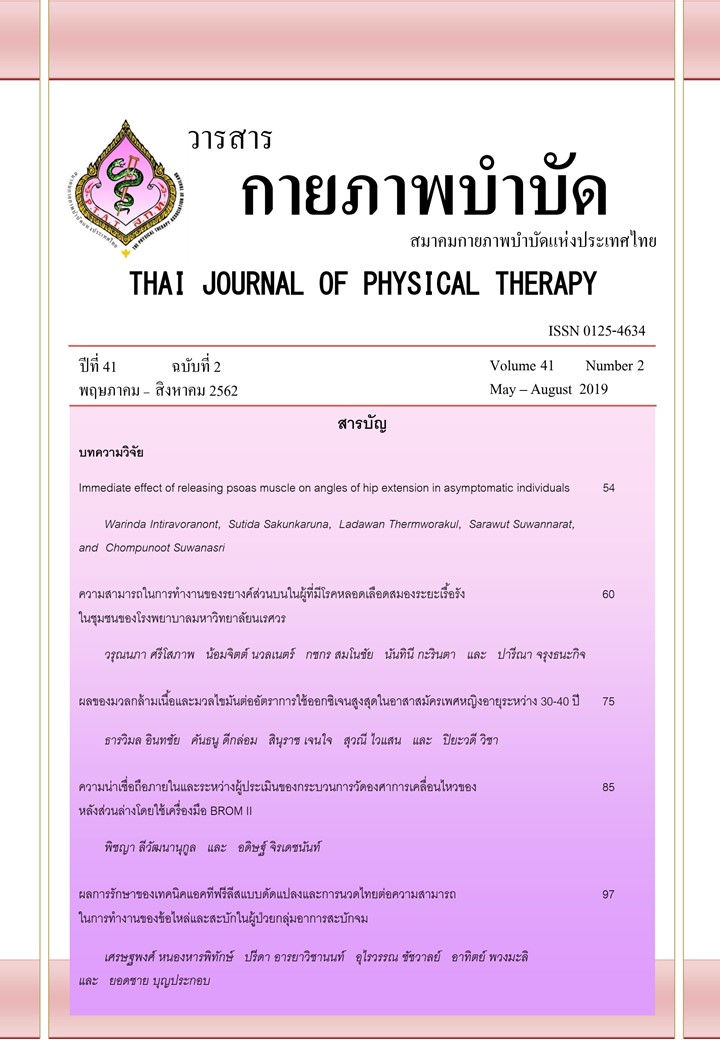ผลทันทีการคลายกล้ามเนื้อ Psoas ต่อมุมการเหยียดข้อสะโพกในคนสุขภาพดี
Main Article Content
บทคัดย่อ
ที่มาและความสำคัญ: การคลายกล้ามเนื้อ psoas สามารถลดอาการปวดหลังและสะโพกได้ แต่ยังไม่พบการศึกษาผลทันทีของการกดคลายกล้ามเนื้อ psoas ต่อมุมการเหยียดข้อสะโพก
วัตถุประสงค์: เพื่อศึกษาผลทันทีการคลายกล้ามเนื้อ psoas ต่อมุมการเหยียดข้อสะโพกในกลุ่มคนสุขภาพดี
วิธีการวิจัย: ผู้เข้าร่วมวิจัยสุขภาพดีทั้งชายและหญิงจำนวน 30 ราย ได้รับการตรวจร่างกายทางกายภาพบำบัด รวมถึงการตรวจการตึงตัวของกล้ามเนื้อ psoas โดยมีการตรวจวัดมุมการเหยียดข้อสะโพกร่วมด้วย ได้รับการคลายกล้ามเนื้อ psoas ข้างที่มีความตึงตัว และทำการวัดมุมการเคลื่อนไหวของการเหยียดข้อสะโพกหลังทำการกดคลายกล้ามเนื้อ
ผลการวิจัย: พบค่าที่เพิ่มขึ้นอย่างมีนัยสำคัญของมุมการเหยียดข้อสะโพกก่อนและทันทีหลังการกดคลายกล้ามเนื้อ psoas
สรุปผล: ผลการศึกษานี้แสดงถึงการกดคลายกล้ามเนื้อ psoas มีผลต่อการเพิ่มขึ้นของมุมการเหยียดข้อสะโพกในคนสุขภาพดี
Article Details
เอกสารอ้างอิง
2. Quinn A. Hip and groin pain: Physiotherapy and rehabilitation issues. TOSMJ. 2010; 4:93-107.
3. Amir MA, Mohammad NR, Ali M. The relationship between hamstring length and gluteal muscle strength in individuals with sacroiliac joint dysfunction. J Man Manip Ther. 2011;19(1):5-10.
4. Nadler SF, Malanga GA, Feinberg JH, Prybicien M, Stitik TP, DePrince M. Relationship between hip muscle imbalance and occurrence of low back pain in collegiate athletes. A prospective study. Am J Phys Med Rehabil. 2001; 80:572-7.
5. McGill SM, Patt N, Norman RW. Measurement of the trunk musculature of active males using CT scan radiography: Implications for force and moment generating capacity about the L4/L5 joint. J Biomech.1988;21:329-41.
6. Gibbons SGT. The model of psoas major stability function. Proceedings of :1st International Conference on Movement Dysfunction. Edinburgh, Scotland. 2001; Sept. 21-3.
7. Myers TW. Anatomy trains. Myofascial meridians for manual and movement therapists. 2nd ed.Edinburgh: Churchill Livingston; 2009.
8. Bogduk N, Pearcy M, Hadfield G. Anatomy and biomechanic of psoas major. ClinBiomech.1992; 7: 109-19.
9. Andersson E, Oddsson L, Grundstrom H, Thorstensson A. The role of the psoas and iliacus muscles for stability and movement of the lumbar spine, pelvis and hip. Scand J Med Sci Sports. 1995; 5:10-6.
10. Janda V. Muscle strength in relation to muscle length, pain and muscle imbalance. In: Harms-Ringdahk K, editor. Muscle strength (International perspectives in physical therapy). Vol. 8. Edinburgh: Churchill Livingston; 1993.
11. Page P, Stewart G. Hamstring strength imbalances in athletes with chronic sacroiliac dysfunction. J Orthop Sports Phys Ther. 2000; 30(1): A-48.
12. Nahid KY, Majid M, Naser MR, Elke Z. Comparison of range of motion of knee and hip in athletes with and without patellofemoral pain syndrome. JRAS. 2014;1(3):70-7.
13. Kendall FP, McCreary EK, Provance PG. Muscle testing and function. 4thed. Baltimore: William & Wilkins; 1993.
14. Vigotsky AD, Lehman GJ, Beardsley C, Contreras B, Chung B, Feser EH.The modified Thomas test is not a valid measure of hip extension unless pelvic tilt is controlled. Peer J 2016;4: e2325.
15. Wakefield BC, Halls A, Difilippo N, Cottrell TG. Reliability of goniometric and trigonometric techniques for measuring hip-extension range of motion using the Modified Thomas test. J Athl Train. 2015; 50(5): 460–6.
16. Holm I, Bolstad B, Lutken T, Ervik A, Rokkum M, Steen H. Reliability of goniometric measurements and visual estimates of hip ROM in patients with osteoarthrosis. Physiother Res Int. 2000;5(4): 241–8.


